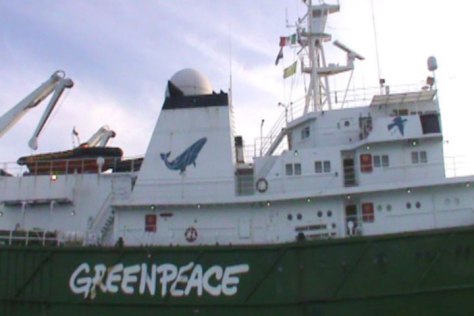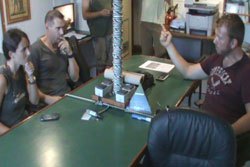Aboard the ship Esperanza Amsterdam (Greenpeace) .- from crisolvirtual.wordpress.com
 After the meeting between members of Greenpeace and the Federation of Fishermen of San Felipe, a historic agreement was reached for the fishing industry and conservationists to work together in protecting the vaquita and other species of the Sea of Cortez.
After the meeting between members of Greenpeace and the Federation of Fishermen of San Felipe, a historic agreement was reached for the fishing industry and conservationists to work together in protecting the vaquita and other species of the Sea of Cortez.
In a bold initiative that had the president of the Federation of San Felipe Fishermen, Sunshine Rodriguez Peña went to where the Greenpeace research vessel was docked in the bay of San Felipe. Environmentalists on the previous day had published in social networks that gillnets were found in the Protected Zone, which have been banned for causing the deaths of Vaquita whales, according to advocates arguing from different groups of the ecosystem.
In response, Rodríguez Peña called the fishermen to sail from the port of San Felipe to the Greenpeace ship, in order to establish direct communication with those who have made such accusations, which he asserts are false accusations because the nets found were installed without using boats or any mechanical means, only human effort, which is allowed by law. It is deemed 'fishing for subsistence' and in no way threatens the security of the Vaquita. This method uses the beaches which Vaquitas rarely approach, being wary and shy animals.
CrisolVirtual was invited to the meeting and noted that both fishermen and Greenpeace have shared goals because both groups advocate for sustainable seafood, which allows for economic development without harming the planet with extinction of a species like the Vaquita.
Rodríguez Peña, among others, was received on board the ship Esperanza Amsterdam by Silvia Diaz, who expressed his pleasure to know that fishermen are in favor of the environment and regretted not having had direct communication with the federation which comprises more than 80 percent of fishermen from the port of San Felipe.
 Silvia Diaz, of Spanish origin, introduced the complaint about gillnets but PROFEPA of San Felipe assured him that gillnets were prohibited. Rodriguez Peña made it clear that such nets installed on the beach take advantage of the low tide and does not violate the law, because it is fishing for consumption and the number of fish caught is too negligible to take to a commercial level.
Silvia Diaz, of Spanish origin, introduced the complaint about gillnets but PROFEPA of San Felipe assured him that gillnets were prohibited. Rodriguez Peña made it clear that such nets installed on the beach take advantage of the low tide and does not violate the law, because it is fishing for consumption and the number of fish caught is too negligible to take to a commercial level.
Another point that was discussed by environmentalists was an assessment of all human activities that damage the ecosystem of the Sea of Cortez, from fishing, mining and lack of fresh water from the Colorado River, which runs beyond the borders.
At this point, special emphasis on the role of the International Committee for the Recovery of the Vaquita (CIRVA) was given because it is an organization which for many years insisted that the gear generically called "Chango" is used, which is a drive system that bounces across the seabed and is anti-ecological and both the federation of fishermen and Greenpeace agreed that it would be a blunder to establish this form of fishing as it has very high bycatch capture rate and causes great damage to the ecosystem.
Another important agreement was related to the cooperation of fishermen in participating in research work, as in the upcoming visit of Greenpeace in the month of September, the seamen of San Felipe could serve as guides and provide their boats to journey to all the parts of the Upper Gulf that are of interest to environmentalists.
Initially there was distrust by the crew members of the vessel Esperanza Amsterdam and they only allowed Sunshine Rodríguez Peña and this reporter to dock. However those of Greenpeace who viewed welcomed some 150 fishermen who grouped together in 30 pangas to join them and this speaks of the interest ahead in the economic activity of fishing, but with environmental responsibility, under the leadership of Sunshine Rodríguez Peña.